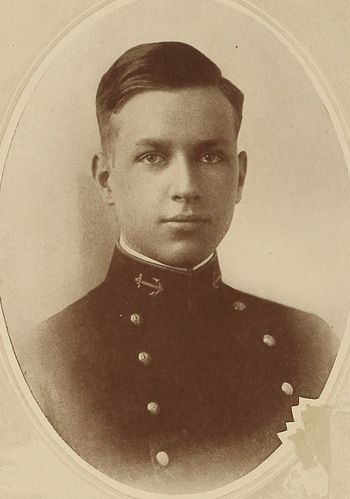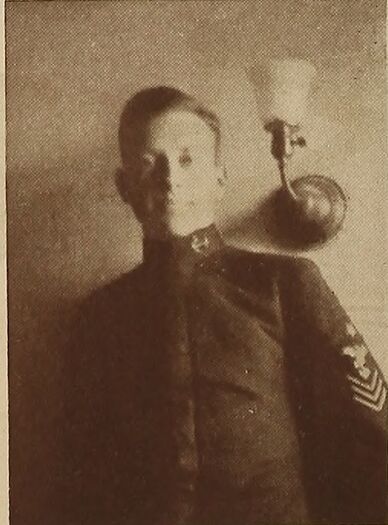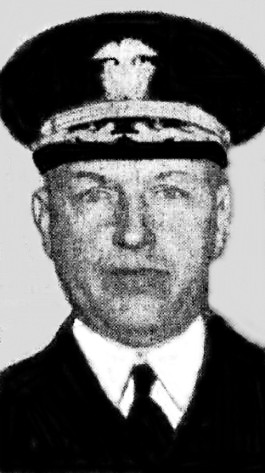CHARLES P. CECIL, RADM, USN
Charles Cecil '16
Lucky Bag
From the 1916 Lucky Bag:
Charles Purcell Cecil
Louisville, Kentucky
"Shorty" "Rummy"
SHORTY is one of those ducks who sets the ladies astir. He is not a fusser of the conspicuous type like Doc Krez and Gracie Wills, but the kind that gets there in an unassuming way and makes a big impression. Out in 'Frisco they all wanted to know where that great big, tall fellow with the reddish tint in his hair, had received his training. When Shorty starts out on the warpath, all of the other wearers of the pink N had better stand from under, as he hypnotizes them from long range. He has taught his faithful frau Fuzz all his tricks and he now (Fuzz) can tell you all of the dope on the moonshine stills of Kentucky.
Charles is as congenial with the men as with the ladies. In a life like ours it is a great relief to come upon a man in this motley crew, to whom you can go and ask a favor, with the knowledge that it will be granted without your having to give the whys and wherefores. That is how it is in dealing with Charlie. If it is reasonable the deal is as good as closed. It is a sterling quality in any man and without doubt one of the earmarks of a good shipmate.
It would be fine to be able to give an account of how Shorty cleaned up on the Army a few years ago, but he rather looks to languid leisure as a main sport, although he has done his share toward making the class football team do its duty on a couple of occasions, and every now and then he turns up on the river with a trusty oar. I said now and then, mostly then. Charlie will make a good officer, for he has more than the ordinary intelligence.
"Come on in, Shorty, and make yourself at home in any old J. O. mess you choose, for you will always be welcome."
Buzzard.

Charles Purcell Cecil
Louisville, Kentucky
"Shorty" "Rummy"
SHORTY is one of those ducks who sets the ladies astir. He is not a fusser of the conspicuous type like Doc Krez and Gracie Wills, but the kind that gets there in an unassuming way and makes a big impression. Out in 'Frisco they all wanted to know where that great big, tall fellow with the reddish tint in his hair, had received his training. When Shorty starts out on the warpath, all of the other wearers of the pink N had better stand from under, as he hypnotizes them from long range. He has taught his faithful frau Fuzz all his tricks and he now (Fuzz) can tell you all of the dope on the moonshine stills of Kentucky.
Charles is as congenial with the men as with the ladies. In a life like ours it is a great relief to come upon a man in this motley crew, to whom you can go and ask a favor, with the knowledge that it will be granted without your having to give the whys and wherefores. That is how it is in dealing with Charlie. If it is reasonable the deal is as good as closed. It is a sterling quality in any man and without doubt one of the earmarks of a good shipmate.
It would be fine to be able to give an account of how Shorty cleaned up on the Army a few years ago, but he rather looks to languid leisure as a main sport, although he has done his share toward making the class football team do its duty on a couple of occasions, and every now and then he turns up on the river with a trusty oar. I said now and then, mostly then. Charlie will make a good officer, for he has more than the ordinary intelligence.
"Come on in, Shorty, and make yourself at home in any old J. O. mess you choose, for you will always be welcome."
Buzzard.
Loss
Charles was lost in the crash of a Navy Air Transport Service PB2Y Coronado flying boat taking off from Funafuti Atoll in the Ellice Islands (now known as Tuvalu) on July 31, 1944.
Other Information
From NavSource:
Rear Admiral Cecil was born in Louisville, Kentucky, September 4, 1893. He was appointed to the Naval Academy from the Fifth Kentucky District in 1912. and was graduated and commissioned Ensign in June 1916. After graduation he served aboard USS [ARIZONA], USS BALLARD, USS ROCHESTER, USS [ABEL P. UPSHUR], USS PITTSBURGH, and USS TEXAS through 1927. The next ten years saw Admiral Cecil serving on Battleship Staffs and ashore at the Bureau of Navigation as well as the Naval Academy. During the late thirty's he commanded the destroyers GREEN and CUMMINGS followed by an assignment as Executive Officer, Naval Training Center, Great Lakes, Illinois.
In 1941, at the beginning of World War II he assumed command of Pacific Destroyer Division Eleven followed by command of Destroyer Squadron Five. He was awarded the Navy Cross for Action with Destroyer Squadron Five against superior Japanese Forces at the battle of Santa Cruz Islands on 26 October 1942. In November of 1942. Admiral Cecil assumed command of the USS HELENA. On 6 July 1943 he was awarded a Bronze Star Medal and a Gold Star in lieu of a second Navy Cross for extraordinary heroism in action against Japanese forces in the Solomon Islands, Following several days of shore bombardment against numerous counter-battery fire, and the laying of a mine field in restricted waters in reduced visibility, the HELENA participated in a running engagement with numerically superior Japanese Naval Forces. She sank or damaged all hostile vessels before she was mortally hit by enemy torpedo fire.
Subsequent to the sinking of the HELENA Admiral Cecil reported for duty as Commander Service Force, Pacific Fleet. He was killed in an airplane crash in the Pacific area on 31 July 1944.
DD835, the USS CHARLES P. CECIL was named in honor of this superb seaman, destroyer tactician, and gallant leader whose personal courage and inspiring devotion to duty over his lifetime was in keeping with the highest traditions of the United States Naval Service. His widow, Mrs. Charles Purcell Cecil christened this vessel at the launching on 22 April 1945, at the Bath Iron Works Corporation, Bath, Maine. She currently resides in Charleston, South Carolina, and she has been presented a copy of this program along with a brass duplicate of Cecil's commissioning plaque. Charles P. Cecil's decommissioning booklet
(Note the commissioning book seems to be incorrect in two aspects of his early service: The Register of Commissioned and Warrant Officers of the United States Navy and Marine Corps of 1917 shows him aboard Arizona, not Maine. Later, he was aboard USS Abel P. Upshur (DD 193), not USS Upshur (DD 144).)
From Arlington National Cemetery.net, dated August 14, 1944:
On a day in July 1943, a sorry looking group of Navy men—officers and blue-jackets, all lucky to be alive—waded ashore on a Pacific island. Among them was Charles P. Cecil, tall, cold-eyed skipper of the heroic cruiser Helena, which had been torpedoed in the July 7 Battle of Kula Gulf. With the others, Captain Cecil had floated for hours in the oil-covered waters. He had refused to be picked up until his men were rescued.
It was the second ship Cecil had lost to the enemy. In the Battle of Santa Cruz, in October 1942, he had commanded the lost destroyer Porter. He ruefully remarked: "I guess they have my number."
Last week his number was crossed out. Rear Admiral Charles P. Cecil, 50, holder of a Navy Cross with Gold Star (i.e., two crosses), died when an airplane in which he was riding crashed at a Pacific base.
The Naval History and Heritage Command Director's "H-Gram" H-020 has much more detail on his actions as commanding officer of Helena.
From the News and Courier, Charleston, July 13, 1943 via researcher Kathy Franz:
Captain Charles P. Cecil, of Louisville, well known in Charleston, has reached an Allied base in the South Pacific after his ship, the cruiser Helena, was lost in the battle of Kula gulf on July 6. The Helena had more fighting in the Pacific than any other American warship, and Captain Cecil said she accounted for three Japanese destroyers and damaged three cruisers before going down from torpedo hits.
“It was just like ten pins,” he was quoted as saying in an Associated Press dispatch. They set them up and we knocked ‘em down.
“I never saw the Helena put out shells so fast The main batteries seemed to be firing even faster than the secondaries.
“We approached the Kula gulf area from the east at high speed, hoping to meet the Japanese surface forces. Our task force commander maneuvered our forces into favorable position to attack. It all happened in the space of a few minutes.
“All the initial salvoes from the cruisers appeared to have been fired simultaneously – as if a master switch had been pressed. I feel confident that my ship had the hitting range with the first salvo.
“We maintained fire for a brief space of time on the initial target, believed to be a cruiser, until it disappeared. Then we switched to the second target, probably a cruiser, until it disappeared. Then we switched to another cruiser and fired several salvoes.”
Then the enemy’s light forces closed in, and the secondary batteries of the American warships opened on them.
“Our forces knocked them out one after another as they closed the range,” Captain Cecil said, “But at least one succeeded in launching the torpedoes that gave the Helena its fatal blows.”
The night was dark and the torpedo wakes could not be observed until too late to avoid them.
Captain Cecil did not see the enemy ships explode.
“They just seemed to deteriorate and disappear,” he said.
There was no fire on the Helena and no confusion.
“Some of our men even went on sight-seeing trips to see what had happened,” he said.
Captain Cecil was the last to leave the ship. He wanted to make certain all the life rafts were clear. He was in the water five hours and on a raft for ten hours before reaching the beach. Salvoes fell among the survivors during the fighting which continued after the Helena went down. The sea was dotted with small lights held by survivors in the water. “The Helena’s men attracted rescuing destroyers by shouting “Hip, hip, hurray!”
Other survivors of the Helena said that Captain Cecil stayed with the ship as long as possible and refused several opportunities to be rescued by a destroyer because he preferred to remain with his group in rafts and boats. There was so little room on the rafts that the men took turns getting into the water and hanging on. Several times Captain Cecil insisted on remaining in the water when it was his turn to get aboard the raft.
From researcher Kathy Franz:
Charles graduated from the du Pont Manual Training High School.
On the 1920 census taken on February 12, Charles was on the USS Ballard stationed in Chatham, England.
He married Mary Randolph Pelzer in 1923. Their children were Charles born in 1926 (’49), Mary Randolph born in 1928 who became Mrs. Richard D. Cutler, and Anthony Pelzer Cecil born in 1938. Charles’ widow married South Carolina Senator Burnet R. Maybank in January 1949. She died in 1994.
Mary and her two children, Mary and Anthony, sailed to Honolulu in August 1941. Charles had command of a destroyer squadron there since June. They were there during the Pearl Harbor attack, and Mary and the two children sailed back to Los Angeles in January 1942.
In October 1942, Porter was Charles’ flagship. He was rescued when it was sunk by the Japanese in the Solomon Islands battle.
Charles was first buried in the South Pacific area. His body was returned with the first shipload of World War II fallen in October 1947, on the Honda Knot at San Francisco. He was re-interred at Arlington National Cemetery on November 7.
Charles’ father Samuel was a railroad clerk who died the year after Charles was born. Charles’ mother was Florence. In 1900, her son Albert Thompson lived with them, and he was a bookkeeper.
His wife was listed as next of kin; he was also survived by his son, Charles Jr., a graduate of the Naval Academy. Charles is buried in Arlington National Cemetery and has a memorial plaque in a church in North Carolina.
Photographs
From Hall of Valor:
The President of the United States of America takes pleasure in presenting the Navy Cross to Captain Charles Purcell Cecil, United States Navy, for extraordinary heroism and distinguished service in the line of his profession as Commander, Destroyer Squadron FIVE, during the engagement with enemy Japanese forces north of the Santa Cruz Islands on 26 October 1942. Captain Cecil conducted his group so that units under his command maneuvered skillfully in forming a tight defensive screen around a United States carrier in spite of intense and violent action sustained for an hour and a half. Captain Cecil's inspiring leadership and the valiant devotion to duty of his command contributed in large measure to the outstanding success of these vital missions and reflect great credit upon the United States Naval Service.
General Orders: Bureau of Naval Personnel Information Bulletin No. 314 (May 1943)
Service: Navy
Division: Destroyer Squadron 5
From Hall of Valor:
The President of the United States of America takes pride in presenting a Gold Star in lieu of a Second Award of the Navy Cross (Posthumously) to Captain Charles Purcell Cecil, United States Navy, for extraordinary heroism and distinguished service in the line of his profession as Commanding Officer of the Light Cruiser U.S.S. HELENA (CL-50), during operations in Kula Gulf, Solomon Islands, on 5 and 6 July 1943. Commanding his warship during landing operations on New Georgia island, Captain Cecil skillfully maneuvered his ship through submarine-infested waters and effectively bombarded Japanese shore batteries in the face of intense gun and torpedo fire. Twenty-four hours later the Helena participated in an engagement with a numerically superior force and contributed materially to the sinking or severe damaging of all the enemy ships before she was struck by a torpedo. Captain Cecil, calmly and without confusion, directed the abandonment of his sinking ship, and continued supervision of rescue operations from a small life raft. Captain Cecil's inspiring leadership and the valiant devotion to duty of his command contributed in large measure to the outstanding success of these vital missions and reflect great credit upon the United States Naval Service.
General Orders: Bureau of Naval Personnel Information Bulletin No. 319 (October 1943)
Service: Navy
Division: U.S.S. Helena (CL-50)
Bronze Star
From "The State" on January 19, 1946 via researcher Kathy Franz:
Washington, Jan. 18-(AP)_-The Bronze Star medal for heroism in mine-laying operations in the Solomons Islands was awarded posthumously today to Rear Admiral Charles P. Cecil, who was killed in a plane crash in the Pacific July 31, 1944. His widow Mrs. Mary Randolph Pelzer Cecil, lives at 51 Meeting Street, Charleston, S.C.
Namesake
USS Charles P. Cecil (DD 835) was named for Charles; the ship was sponsored by his widow.
Related Articles
Horatio Sickel, IV ’20 was also lost in this crash.
Elmer Buerkle '25, John Mooney, Jr. '35, Arthur Yeates, Jr. '38, and Joseph Griffin '43 were lost when Helena was sunk.
The "Register of Commissioned and Warrant Officers of the United States Navy and Marine Corps" was published annually from 1815 through at least the 1970s; it provided rank, command or station, and occasionally billet until the beginning of World War II when command/station was no longer included. Scanned copies were reviewed and data entered from the mid-1840s through 1922, when more-frequent Navy Directories were available.
The Navy Directory was a publication that provided information on the command, billet, and rank of every active and retired naval officer. Single editions have been found online from January 1915 and March 1918, and then from three to six editions per year from 1923 through 1940; the final edition is from April 1941.
The entries in both series of documents are sometimes cryptic and confusing. They are often inconsistent, even within an edition, with the name of commands; this is especially true for aviation squadrons in the 1920s and early 1930s.
Alumni listed at the same command may or may not have had significant interactions; they could have shared a stateroom or workspace, stood many hours of watch together, or, especially at the larger commands, they might not have known each other at all. The information provides the opportunity to draw connections that are otherwise invisible, though, and gives a fuller view of the professional experiences of these alumni in Memorial Hall.
January 1917
March 1918
January 1919
January 1920
January 1921
January 1922
May 1923
July 1923
September 1923
November 1923
January 1924
March 1924
May 1924
July 1924
September 1924
November 1924
January 1925
March 1925
April 1927
October 1927
January 1928
April 1928
July 1928
October 1928
January 1929
April 1929
July 1929
LTjg Robert Hollenbeck '26 (USS New York)
ENS Douglas Fox '26 (USS New York)
October 1929
LTjg Robert Hollenbeck '26 (USS New York)
ENS Hugh Black '26 (USS New York)
ENS James Willis '27 (USS New York)
ENS Howard Garner '29 (USS New York)
January 1930
LTjg Hugh Black '26 (USS New York)
LTjg Douglas Fox '26 (USS New York)
ENS Leonard Southerland '27 (Observation Plane Squadron (VO) 3B)
ENS Howard Garner '29 (USS New York)
April 1930
October 1930
LTjg Gerald Dyson '27 (Observation Plane Squadron (VO) 4B)
ENS John Burke '28 (USS New Mexico)
January 1931
LTjg Theodore Marshall '24 (Observation Plane Squadron (VO) 5B)
April 1931
July 1931
October 1931
January 1932
ENS Robert Germany, Jr. '30 (Battleship Division 4)
April 1932
ENS Robert Germany, Jr. '30 (Battleship Division 4)
October 1932
LT Robert Smith '20
LT Paul Register '21
LT Francis Bridget '21
LT George Brooke '21
LT William Hobby, Jr. '23
LTjg Neville McDowell '24
LTjg Hubert Hayter '24
January 1933
LT Robert Smith '20
LT Paul Register '21
LT Francis Bridget '21
LT George Brooke '21
LT William Hobby, Jr. '23
LTjg Neville McDowell '24
LTjg Hubert Hayter '24
April 1933
LT Robert Smith '20
LT Paul Register '21
LT Francis Bridget '21
LT George Brooke '21
LT William Hobby, Jr. '23
LTjg Neville McDowell '24
LTjg Hubert Hayter '24
LTjg Lawrence McPeake '24
July 1933
LCDR Lyman Swenson '16
LT Robert Smith '20
LT Paul Register '21
LT George Brooke '21
LT Howard Healy '22
1LT Charles Kail '23
LT Hallsted Hopping '24
LTjg Lawrence McPeake '24
LTjg James Smith, Jr. '25
LTjg Knowlton Williams '25
October 1933
LCDR Lyman Swenson '16
LT Robert Smith '20
LT Paul Register '21
LT George Brooke '21
LT Howard Healy '22
1LT Charles Kail '23
LT Hallsted Hopping '24
LTjg Lawrence McPeake '24
LTjg William Graham, Jr. '25
LTjg Andrew Harris '25
LTjg James Smith, Jr. '25
April 1934
LCDR Lyman Swenson '16
LT Robert Smith '20
LT Paul Register '21
LT William Gray '21
LT George Brooke '21
LT Howard Healy '22
1LT Charles Kail '23
LT Hallsted Hopping '24
LT Lawrence McPeake '24
LTjg William Graham, Jr. '25
LTjg Andrew Harris '25
July 1934
LCDR Albert Rooks '14
LT Paul Register '21
LT William Gray '21
LT George Brooke '21
LT Howard Healy '22
LT Edward Metcalfe '22
LT Eugene Elmore '22
1LT Charles Kail '23
LTjg William Graham, Jr. '25
LTjg John Graff '26
October 1934
LCDR Albert Rooks '14
LT Paul Register '21
LT William Gray '21
LT George Brooke '21
LT John French '22
LT Howard Healy '22
LT Edward Metcalfe '22
LT Eugene Elmore '22
1LT Charles Kail '23
January 1935
LCDR Albert Rooks '14
LT Paul Register '21
LT William Gray '21
LT George Brooke '21
LT John French '22
LT Howard Healy '22
LT Edward Metcalfe '22
LT Eugene Elmore '22
1LT Charles Kail '23
April 1935
LCDR Albert Rooks '14
LT Paul Register '21
LT William Gray '21
LT George Brooke '21
LT John French '22
LT Howard Healy '22
LT Edward Metcalfe '22
LT Eugene Elmore '22
LTjg Heywood Edwards '26
LTjg John Reybold '26
October 1935
January 1936
April 1936
July 1936
January 1937
April 1937
September 1937
January 1938
July 1938
January 1939
October 1939
June 1940
November 1940
April 1941
Charles is one of 15 members of the Class of 1916 on Virtual Memorial Hall.

The "category" links below lead to lists of related Honorees; use them to explore further the service and sacrifice of alumni in Memorial Hall.

